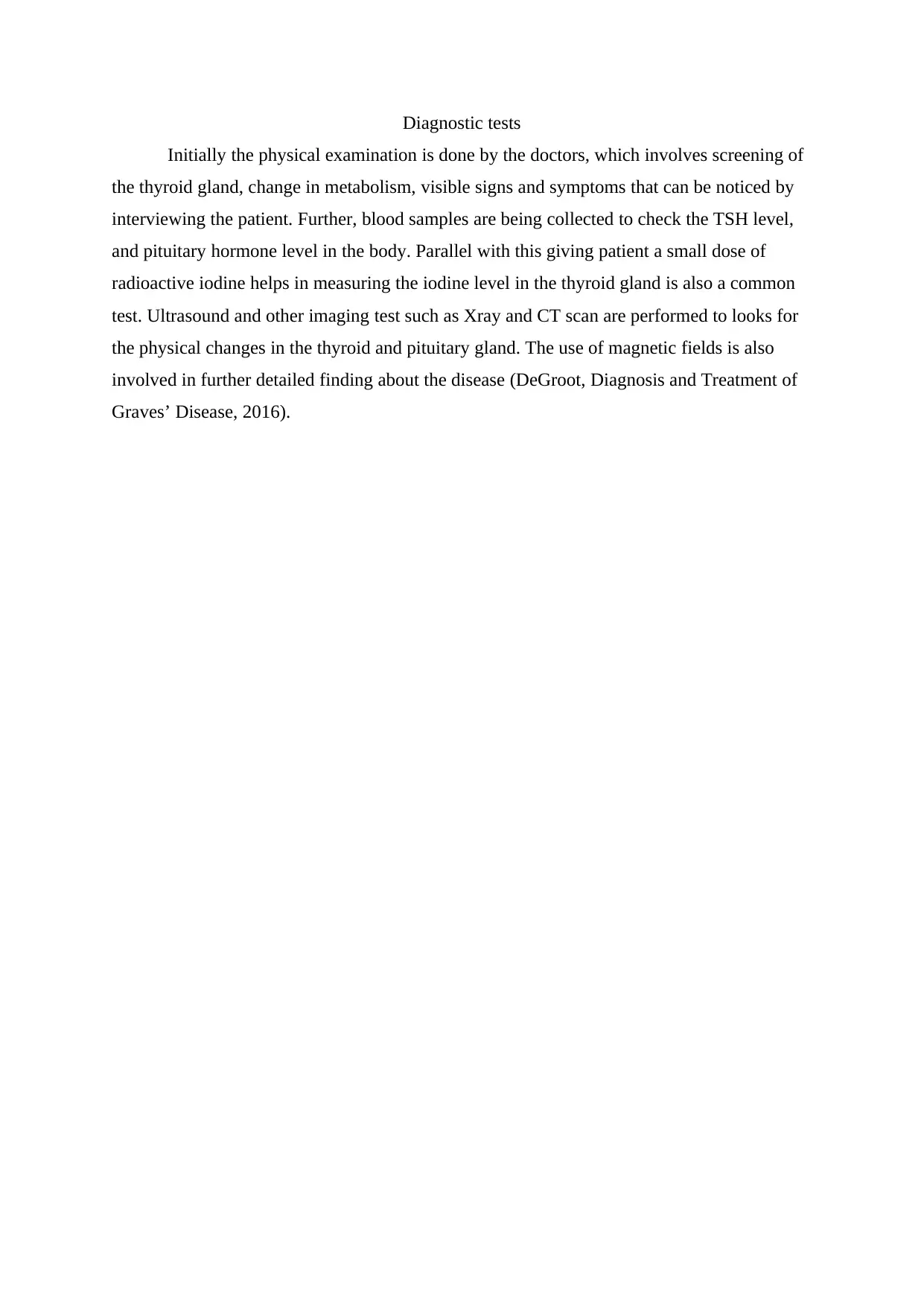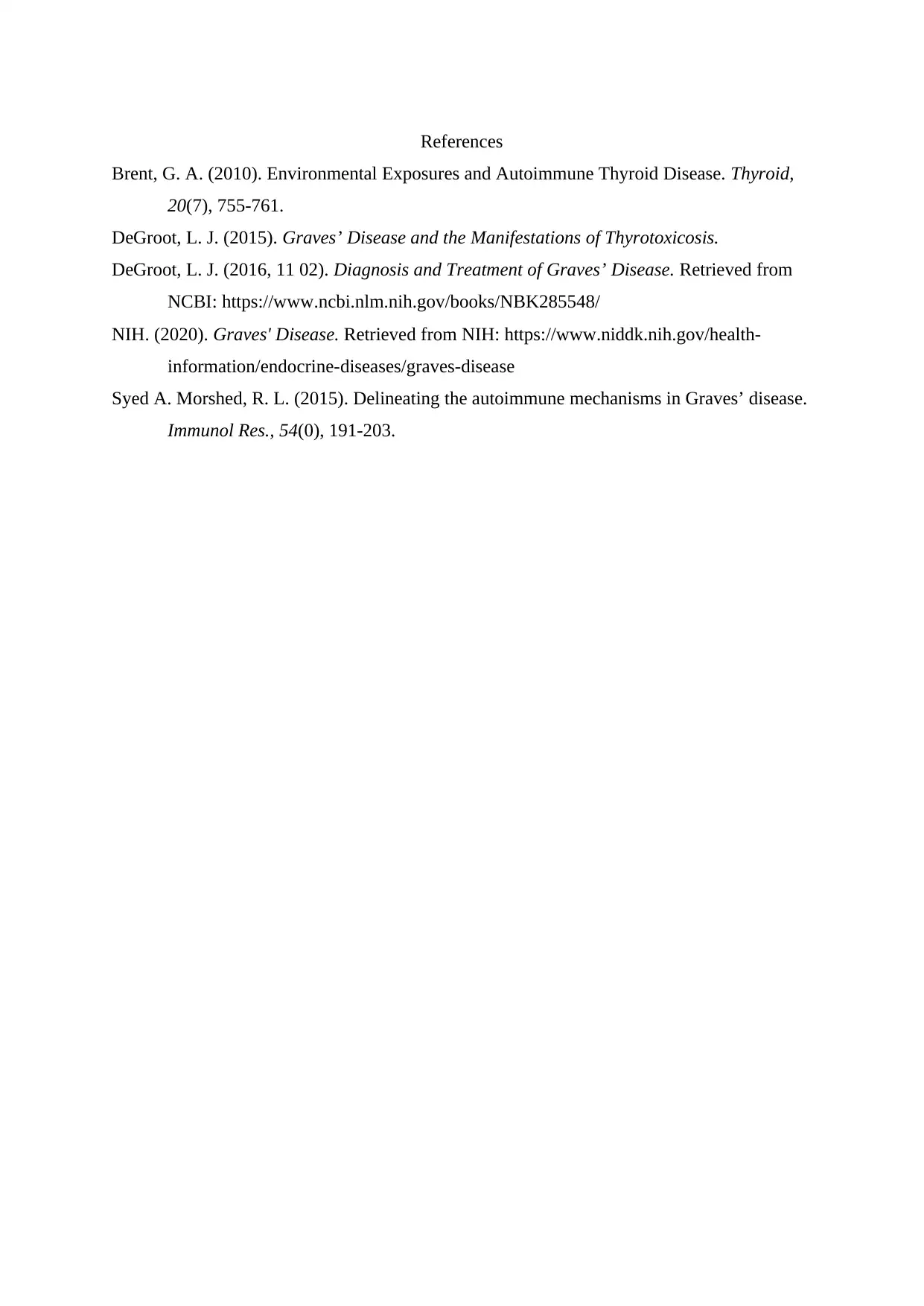Pathophysiology of Graves' Disease: Alterations in Endocrine System
VerifiedAdded on 2022/09/09
|5
|702
|18
Report
AI Summary
This report provides a detailed overview of Graves' disease, an autoimmune disorder causing hyperthyroidism. It explores alterations in the endocrine system, potential environmental and hereditary causes, and the immunological mechanisms involving antibodies that stimulate the thyroid gland. The report discusses the impact of Graves' disease on normal body processes, including heart rhythm disorders, weight changes, and psychological effects. It also outlines the diagnostic tests used to identify the condition, such as physical examinations, blood tests, and imaging techniques like ultrasound and CT scans. The report references key medical publications and research findings to support its analysis, making it a comprehensive resource for understanding the pathophysiology of Graves' disease.

Pathophysiology
Graves’ Disease
3-31-2020
Graves’ Disease
3-31-2020
Paraphrase This Document
Need a fresh take? Get an instant paraphrase of this document with our AI Paraphraser

Contents
Alteration in endocrine system...................................................................................................2
Potential reasons.........................................................................................................................2
Immunological mechanism........................................................................................................2
Impact on normal body processes..............................................................................................2
Diagnostic tests..........................................................................................................................2
References..................................................................................................................................3
Alteration in endocrine system...................................................................................................2
Potential reasons.........................................................................................................................2
Immunological mechanism........................................................................................................2
Impact on normal body processes..............................................................................................2
Diagnostic tests..........................................................................................................................2
References..................................................................................................................................3

Alteration in endocrine system
Graves’ disease is considered as the autoimmune disease which causes the thyroid
gland to enlarge and that results in the production of high amount of thyroid hormone. This
condition lads to hyperthyroidism. It also involves suppression of the pituitary response to
TRH. In this the immune system of the body creates antibodies which increases the function
of the thyroid by inhive production of the thyroid hormone or hyperfunctioning of the thyroid
gland. Hence, it hinders the normal functioning of the body (DeGroot, Graves’ Disease and
the Manifestations of Thyrotoxicosis, 2015).
Potential reasons
Since the Donna is works at the construction site, so several environment factors
could be the possible reason for the disease. The environmental factors interfere with the
iodine uptake in the body, which triggers the overproduction of the same. The major agents
that are recorded includes, radiation, nuclear fallout and different contaminates found in air
and dust. Another possible reason could be the excess intake of the iodine in the diet as well
as the hereditary factor since it is transmitted from one generation to another. Additionally,
variety of potential and known risk factors can be considered which includes the impact of
reproductive hormones, pregnancy, trauma or stress, any major infection and environmental
factors. (Brent, 2010).
Immunological mechanism
The immunological response involved in the Graves’ disease I similar to other
autoimmune disease which includes the involvement of the antibodies. The hyperactivity of
the thyroid gland is caused due to the antibodies which are thyroid stimulating. It increases
the functioning of the thyroid follicular cells. It involves the presence of the T cells and B
cells which are antigen reactive in nature. The person has anti thyroglobulin antibodies or anti
thyroid peroxidase antibodies (Syed A. Morshed, 2015).
Impact on normal body processes
It results in the heart rhythm disorders, changes in the functioning of the heart and the
muscles. It also involves anxiety, weight gain and irregular menstrual cycle due to imbalance
of thyroid functioning which can also be recorded in Donna’s case Apart from these weight
loss is observed, enlargement of thyroid gland, frequent bowels and urination, bulges under
eyes, trembling and shaky hands, sleeplessness and insomnia (NIH, 2020) .
Graves’ disease is considered as the autoimmune disease which causes the thyroid
gland to enlarge and that results in the production of high amount of thyroid hormone. This
condition lads to hyperthyroidism. It also involves suppression of the pituitary response to
TRH. In this the immune system of the body creates antibodies which increases the function
of the thyroid by inhive production of the thyroid hormone or hyperfunctioning of the thyroid
gland. Hence, it hinders the normal functioning of the body (DeGroot, Graves’ Disease and
the Manifestations of Thyrotoxicosis, 2015).
Potential reasons
Since the Donna is works at the construction site, so several environment factors
could be the possible reason for the disease. The environmental factors interfere with the
iodine uptake in the body, which triggers the overproduction of the same. The major agents
that are recorded includes, radiation, nuclear fallout and different contaminates found in air
and dust. Another possible reason could be the excess intake of the iodine in the diet as well
as the hereditary factor since it is transmitted from one generation to another. Additionally,
variety of potential and known risk factors can be considered which includes the impact of
reproductive hormones, pregnancy, trauma or stress, any major infection and environmental
factors. (Brent, 2010).
Immunological mechanism
The immunological response involved in the Graves’ disease I similar to other
autoimmune disease which includes the involvement of the antibodies. The hyperactivity of
the thyroid gland is caused due to the antibodies which are thyroid stimulating. It increases
the functioning of the thyroid follicular cells. It involves the presence of the T cells and B
cells which are antigen reactive in nature. The person has anti thyroglobulin antibodies or anti
thyroid peroxidase antibodies (Syed A. Morshed, 2015).
Impact on normal body processes
It results in the heart rhythm disorders, changes in the functioning of the heart and the
muscles. It also involves anxiety, weight gain and irregular menstrual cycle due to imbalance
of thyroid functioning which can also be recorded in Donna’s case Apart from these weight
loss is observed, enlargement of thyroid gland, frequent bowels and urination, bulges under
eyes, trembling and shaky hands, sleeplessness and insomnia (NIH, 2020) .
⊘ This is a preview!⊘
Do you want full access?
Subscribe today to unlock all pages.

Trusted by 1+ million students worldwide

Diagnostic tests
Initially the physical examination is done by the doctors, which involves screening of
the thyroid gland, change in metabolism, visible signs and symptoms that can be noticed by
interviewing the patient. Further, blood samples are being collected to check the TSH level,
and pituitary hormone level in the body. Parallel with this giving patient a small dose of
radioactive iodine helps in measuring the iodine level in the thyroid gland is also a common
test. Ultrasound and other imaging test such as Xray and CT scan are performed to looks for
the physical changes in the thyroid and pituitary gland. The use of magnetic fields is also
involved in further detailed finding about the disease (DeGroot, Diagnosis and Treatment of
Graves’ Disease, 2016).
Initially the physical examination is done by the doctors, which involves screening of
the thyroid gland, change in metabolism, visible signs and symptoms that can be noticed by
interviewing the patient. Further, blood samples are being collected to check the TSH level,
and pituitary hormone level in the body. Parallel with this giving patient a small dose of
radioactive iodine helps in measuring the iodine level in the thyroid gland is also a common
test. Ultrasound and other imaging test such as Xray and CT scan are performed to looks for
the physical changes in the thyroid and pituitary gland. The use of magnetic fields is also
involved in further detailed finding about the disease (DeGroot, Diagnosis and Treatment of
Graves’ Disease, 2016).
Paraphrase This Document
Need a fresh take? Get an instant paraphrase of this document with our AI Paraphraser

References
Brent, G. A. (2010). Environmental Exposures and Autoimmune Thyroid Disease. Thyroid,
20(7), 755-761.
DeGroot, L. J. (2015). Graves’ Disease and the Manifestations of Thyrotoxicosis.
DeGroot, L. J. (2016, 11 02). Diagnosis and Treatment of Graves’ Disease. Retrieved from
NCBI: https://www.ncbi.nlm.nih.gov/books/NBK285548/
NIH. (2020). Graves' Disease. Retrieved from NIH: https://www.niddk.nih.gov/health-
information/endocrine-diseases/graves-disease
Syed A. Morshed, R. L. (2015). Delineating the autoimmune mechanisms in Graves’ disease.
Immunol Res., 54(0), 191-203.
Brent, G. A. (2010). Environmental Exposures and Autoimmune Thyroid Disease. Thyroid,
20(7), 755-761.
DeGroot, L. J. (2015). Graves’ Disease and the Manifestations of Thyrotoxicosis.
DeGroot, L. J. (2016, 11 02). Diagnosis and Treatment of Graves’ Disease. Retrieved from
NCBI: https://www.ncbi.nlm.nih.gov/books/NBK285548/
NIH. (2020). Graves' Disease. Retrieved from NIH: https://www.niddk.nih.gov/health-
information/endocrine-diseases/graves-disease
Syed A. Morshed, R. L. (2015). Delineating the autoimmune mechanisms in Graves’ disease.
Immunol Res., 54(0), 191-203.
1 out of 5
Related Documents
Your All-in-One AI-Powered Toolkit for Academic Success.
+13062052269
info@desklib.com
Available 24*7 on WhatsApp / Email
![[object Object]](/_next/static/media/star-bottom.7253800d.svg)
Unlock your academic potential
Copyright © 2020–2025 A2Z Services. All Rights Reserved. Developed and managed by ZUCOL.





